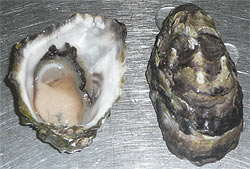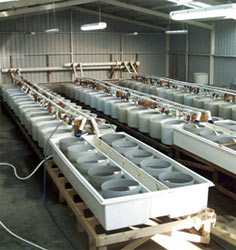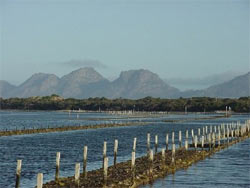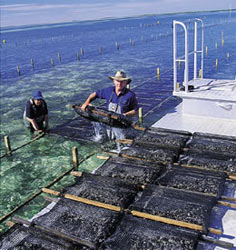Mariculture in South Australia
Pacific oyster
The Pacific oyster or Japanese Oyster, (Crassostrea gigas), is native to the Pacific coast of Asia. It has been introduced to Australia, North America, Europe, and New Zealand. They are found in intertidal and subtidal zones, usually attached to hard or rocky surfaces in shallow or sheltered waters. They have a fairly thin shell with no hinge teeth on the inner, upper shell.
Pacific oysters prefer a water temperature of 14°C to 18°C to reproduce. They are filter feeders eating phytoplankton (or microalgae),
bacteria, detritus and viruses.(see Sydney Rock Oysters for more information). Their larvae live amongst the plankton for three to four weeks until a suitable surface to settle on is found. It spends the first year of its attached life as a male, before becoming a female. Oysters can live up to 10 years and reach an average size of 15 to 20 cm. |

|
| |
|
Pacific oysters were introduced to Australia for aquaculture in the 1940's but have spread and invaded intertidal habitats of many waterways.
They are a hardy species with fast growth and high reproductive rates allowing them to establish dense populations in some areas, often displacing native intertidal species. They have caused major problems forSydney rock oysters farmers as the two species live and spawn in the same locations, Pacific oysters can settle on and smother farmed Sydney rock oysters because of their faster growth rate.
Pacific oysters have been listed as a Class 2 noxious species in all NSW waters except Port Stephens where they are farmed.
Farming Pacific oysters
They are farmed in Tasmania and South Australia and in Port Stephens in New South Wales. In South Australia, the total direct business turnover of oyster farming was almost $31 million in 2002/03. Of this, $16.1 million was from the farm gate and the rest from processing, transport, retail and food service industries.
320 people were directly employed in oyster farming. Most of the oysters are grown in Coffin Bay, north-west of Port Lincoln. |

|
| |
|
Pacific Oyster hatcheries are built on land. Sexually mature oysters spawn in the hatchery then
the larvae and spat are grown until they reach a size suitable for on-growing in a nursery site.
As well, the hatcheries need to grow large amount of different types of microalgae to feed the developing oysters.
As the oysters grow they settle crushed shells, then sieves are used to remove them from the tanks and they are moved to indoor
nursery tanks. Once the spat reach 3 to 15mm in
length they are sold to farmers for on-growing in intertidal or
subtidal sites.
There are a number of methods for growing the spat. These include:
Intertidal racks and baskets
Rectangular shaped baskets, made from tough polypropylene mesh, are attached to the
racks by two 1m long wooden sticks (approximately ). The racks are made of wooden
posts (uprights) which are drilled vertically into the seabed to provide support. Attached to these are more wooden posts which run parallel to the seabed and hold
up the baskets | 
|
| |
|
Intertidal racks and trays
Instead of baskets, trays are used. These provide greater protection for the growing oysters. The trays are made of wooden frames with mesh covering attached to the racks.
Intertidal Long-lines
In this method, ;onglines and bags are used to on-grow oysters. The
bags are made of polypropylene mesh; cylindrical in shape, 90cm length x 15cm diameter, and
hung on a wire suspended by wooden uprights. The height of
the wire can be adjusted so the oyster bags can be lowered or raised depending on the tide.
Subtidal Long-lines
In some parts of SA, farmers have access to sub-tidal sites where sub-surface or surface
longlines are used to suspend a series of stacked trays (approximately 1.5 x 1.5m). These
longlines are attached to the sea-bed and supported by buoys.
For more information see
www.pir.sa.gov.au/__data/assets/pdf_file/0004/33979/oyster.pdf
|

|
|
|